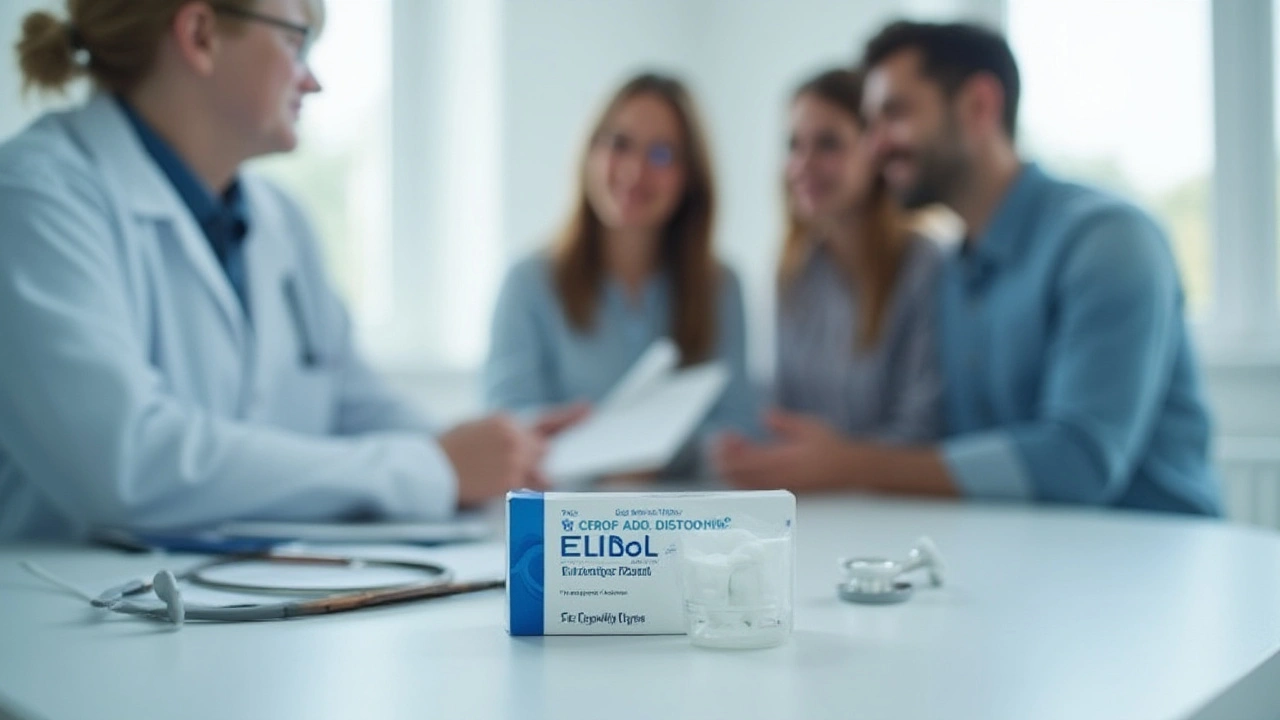Ever noticed an itchy red patch that just refused to go away, no matter how much you tried to avoid scratching? If so, you’re not alone—and you’re definitely not strange. Loads of people, both kids and adults, battle skin conditions like eczema, and that’s where a little white tube of hope called Elidel comes in. It’s been around for over twenty years, and doctors rave about its ability to dial down itch and redness. But there’s more to this stuff than meets the eye. Is it a miracle cure, or are there catches you should know about? Grab a cuppa and let’s unravel the facts about Elidel cream together.
What Is Elidel and How Does It Actually Work?
Elidel, officially known as pimecrolimus cream 1%, isn’t your average over-the-counter moisturizer. It’s a type of non-steroidal anti-inflammatory cream that’s made headlines since the early 2000s for treating atopic dermatitis—what most people just call eczema. Instead of tackling bacteria like an antibiotic, or thinning the skin like steroids sometimes do, Elidel takes a smarter approach by soothing the immune response at the source. Think of it like telling your skin’s overreacting bouncers to calm down and let the good guests in, while keeping out the troublemakers. This stops the endless cycle of itch-scratch-inflammation most eczema sufferers dread.
Elidel doesn’t contain steroids, which is a big deal for folks who worry about those classic side effects—thinning skin, discolouration, or the so-called ‘steroid withdrawal’ some fear. Instead, its active ingredient pimecrolimus belongs to a group called topical calcineurin inhibitors. These compounds simply block the body’s internal messenger (calcineurin) that kicks off the immune response leading to itch and rash. The cream gets absorbed into the top layer of skin but doesn’t go deep enough into your bloodstream to cause trouble elsewhere. This is why GPs and dermatologists often consider it for kids as young as 2, which is rare for prescription skin treatments.
The cool science here? Since its launch, Elidel has been studied worldwide, with trials across the UK, the US, and Europe confirming its effectiveness on mild to moderate eczema. While each country’s drug regulators have a different take on who should use it and for how long, a review in the British Journal of Dermatology from 2023 said pimecrolimus remains one of the safest non-steroidal choices for long-term skin management, especially when steroid anxiety lingers. That said, Elidel won’t work instantly—it can take a few days to calm a flare-up, but the relief usually lasts without the risk of overusing it, as can happen with some steroid creams.
When Should You Use Elidel and Who Is It For?
If you’ve ever consulted a dermatologist about eczema in the UK, odds are good you’ve heard Elidel mentioned at some point. But it’s not for everyone, and it’s not the first choice for every flare-up. Doctors recommend Elidel for patients—often children—who have mild to moderate atopic dermatitis, especially in spots where the skin is thinner or more sensitive, like the face, neck, or folds behind your knees. If you’ve tried emollients (those thick, greasy moisturisers) and mild steroid creams without much long-term success, that’s usually when Elidel makes its entrance.
It’s also especially handy for people who need long-term control but can’t use steroids daily. Think kids who get breakouts on their cheeks, adults who wrestle with repeated flare-ups on eyelids, or people who’ve noticed steroid creams cause side effects like stretch marks. Elidel’s light texture and low absorption rate mean it’s less likely to cause skin-thinning or pigment issues, making it a go-to cream for delicate areas. Parents find this reassuring since long-term steroid use around children’s eyes or sensitive facial skin always sparks worry.
That said, there are situations where Elidel isn’t recommended. If you have a skin infection—like cold sores, oozing eczema, or impetigo—most doctors will tell you to treat that first. Elidel is also a no-go if you have certain rare immune issues or are allergic to pimecrolimus. Pregnant or breastfeeding? It might not be your best choice, since long-term effects aren’t totally mapped out. And let’s be honest—if you’re hoping it’ll solve severe, cracked, bleeding rashes instantly, you’ll likely be disappointed. It’s a steady player, not a miracle midfielder.
If you’re curious, here’s a quick look at where Elidel stands in the eczema treatment line-up:
| Treatment | Best For | Main Perks | Main Cautions |
|---|---|---|---|
| Emollients (moisturisers) | All eczema types | Safe, soothing, cheap | Can be greasy |
| Steroid creams | Mild to severe flares | Fast-acting | Skin thinning risk |
| Elidel | Mild to moderate, sensitive areas | No steroids, few side effects | Slow onset, not for infections |
| Tacrolimus ointment | Moderate to severe cases | Works fast, for tough areas | May sting more than Elidel |

Tips to Get the Most from Elidel: Real-World Advice
Using Elidel sounds simple—just squeeze a blob onto your finger and rub it in, right? Well, yes, but how and when you use it can make a big difference. Most people are told to apply Elidel twice a day to clean, dry skin, using just enough to cover the patch. No need to slather it on thick like a face mask. The cream goes on smoothly and absorbs quickly, so you don’t get that shiny or greasy look feted by classic ointments.
If you’re juggling several creams—maybe an emollient for all-over moisture and Elidel for stubborn spots—timing matters. Dermatologists recommend using your basic moisturiser first, letting it sink in for at least 30 minutes. Then, apply Elidel to just the affected areas. Don’t rub vigorously—gentle dabbing works better. And definitely don’t mix different treatments together on your skin at the same time—it messes up the absorption and might trigger irritation.
Starting Elidel for the first time might come with a mild burning or tingling sensation—especially if your skin is super raw. Normally, this fades with repeated use and doesn’t mean you should stop. If it’s really unbearable or you spot a rash forming where you applied the cream (rather than the eczema itself), check in with your GP. They’ll rule out allergy or recommend adjusting your treatment. And don’t skimp on sun protection! Pimecrolimus can make the skin more sensitive to UV, so grab a gentle, fragrance-free sunscreen if you’re heading outdoors.
Here’s what people usually ask me as someone who’s spent years swapping kid eczema tips at Bristol playgroups and sharing notes with GPs:
- How long can I use Elidel? Some studies tested it for up to a year—most doctors say it’s fine for ongoing prevention in flare-prone areas as long as you have check-ups every few months.
- Can you use makeup or shaving cream after Elidel? Yes, but give it 30-60 minutes to sink in first. Too many layers mean less absorption.
- Are there non-steroid alternatives if Elidel doesn’t work? There are, like Protopic (tacrolimus ointment) or even new injectables for severe eczema. Each has pros and cons, so don’t be shy about switching if you’re not seeing results.
And here’s a weird but true tip—keep the cream in a cool, dry place. Bathrooms get steamy and hot, which can reduce the potency over time. Stick your tube in a bedroom drawer instead.
Possible Side Effects (and Controversies) to Watch For
Nothing’s perfect, and Elidel comes with side effects—though most are mild. The most common is a temporary, warm, bearish tingling or burning when you first start. If you’re one of those unlucky folks, those stings tend to lessen or vanish after the first few days. You might also spot some redness, itching, or mild swelling at the application site. Rarely, skin can get drier than before, prompting you to moisturise more often. And if you have cold sores or warts popping up, take a pause; Elidel can simmer down your immune ‘guards’ in those patches and let viruses take advantage.
Now, some people have heard stories about Elidel increasing cancer risk. This goes way back to when the cream was first being studied in animals, where extreme, long-term use led to tumours in lab rats. Human studies haven’t shown increased cancer in those using Elidel at normal doses, but the NHS and the US FDA still slap a warning on the insert just in case. No one’s telling you to slather Elidel on head-to-toe for years straight, and in the short bursts used for eczema, dermatologists say it’s very safe.
Check out this breakdown of side effects found in real clinical trials:
| Side Effect | Likelihood (%) | Notes |
|---|---|---|
| Local burning or itching | 10-20% | Mainly start of treatment, fades with time |
| Redness | Up to 15% | Typically mild |
| Viral skin infections | 2-5% | Cold sores or warts |
| Swelling at site | 1-3% | Rare, usually temporary |
| Cancer (in humans) | No proven risk | Warnings based on animal data only |
If your skin gets worse instead of better after starting Elidel, or if you develop new symptoms (like signs of infection: pus, yellow crusting, sudden swelling), don’t wait around—get it checked out quickly. Don’t share your tube with friends or family either: what works wonders for one person can trigger trouble for someone else, especially if they’re fighting an unknown rash or infection.
The big upside: most people using Elidel as prescribed find fewer flares, less reliance on steroids, and a way to finally tame that relentless itch. Since eczema is one of the most common childhood skin disorders in the UK, with over 15% of school-aged children affected, having something non-steroidal and gentle can make life a lot less stressful for families.







Comments
Theunis Oliphant
One must acknowledge that the epidermal barrier, when compromised, precipitates an incessant itch that torments the afflicted. The modern therapeutic arsenal includes both steroidal and non‑steroidal agents, each with distinct pharmacodynamics. Elidel, as a calcineurin inhibitor, operates by modulating intracellular signaling pathways rather than indiscriminately suppressing inflammation. Its lack of corticosteroid‑related atrophy renders it a suitable option for delicate anatomical sites. Nevertheless, prudence dictates that patients remain vigilant for any adverse dermal response.
India Digerida Para Occidente
We need to keep our minds open to the fact that eczema is not merely a cosmetic nuisance but a genuine immunological disturbance. The double‑blind studies from the UK and the US illustrate that pimecrolimus can reduce flare frequency when used correctly. Applying the cream twice daily to clean, dry skin maximises its bioavailability while minimising irritation. If a transient burning sensation occurs, it is typically a sign that the skin barrier is still healing. Hence, perseverance with the regimen is essential for long‑term remission.
Andrew Stevenson
From a pharmacokinetic perspective, pimecrolimus exhibits a high molecular weight that restricts systemic absorption, thereby conferring a favourable safety profile for chronic use. Clinical trials employing the SCORAD index have consistently demonstrated a mean reduction of 12 points after eight weeks of therapy, underscoring its efficacy in moderate atopic dermatitis. Moreover, the drug’s selective inhibition of calcineurin prevents the downstream activation of NF‑AT transcription factors, which are pivotal in the release of interleukin‑2 and interferon‑γ. This mechanistic specificity translates to a lower incidence of epidermal atrophy compared with topical glucocorticoids, as evidenced by histopathological analyses. Patients with facial involvement particularly benefit, given the thin stratum corneum and heightened susceptibility to steroid‑induced hypopigmentation. In practice, the recommended application schedule-morning and evening-allows for optimal tissue saturation while accommodating circadian variations in skin permeability. It is crucial to educate caregivers that the initial pruritic or burning sensation is self‑limiting and does not signify allergic sensitisation. Should the reaction persist beyond five days, a brief therapeutic pause followed by re‑assessment is advisable. Concomitant moisturisation with ceramide‑rich emollients enhances barrier repair and synergises with the anti‑inflammatory action of the calcineurin inhibitor. Additionally, photoprotection is non‑negotiable; broad‑spectrum sunscreen with an SPF of 30 or higher mitigates the photosensitising potential of the active compound. Longitudinal safety data spanning up to three years have not revealed any statistically significant increase in malignancy rates, thereby alleviating the theoretical concerns derived from rodent models. Nonetheless, regulatory agencies maintain a precautionary label, prompting clinicians to perform periodic skin examinations. Real‑world evidence from dermatology registries corroborates the low discontinuation rate attributable to adverse events. In summary, when incorporated into a comprehensive eczema management plan that includes trigger avoidance, skincare optimisation, and patient education, Elidel serves as a cornerstone therapy for sustained disease control.
Kate Taylor
I understand how frustrating the initial tingling can feel, especially when you’re already dealing with relentless itching. It helps to remember that the sensation usually fades within the first few applications as the skin adapts to the medication. Pairing Elidel with a fragrance‑free moisturizer after it has fully absorbed can soothe any residual discomfort. Also, keeping a sunscreen handy is wise, because the cream can increase photosensitivity on exposed patches. If you ever notice unexpected redness or swelling, reach out to your dermatologist promptly-they can adjust the regimen or suggest an alternative. Consistency and patience are key; many patients report marked improvement after a couple of weeks of diligent use.
Hannah Mae
Honestly, i think Elidel is overrated and you could just use plain aloe.
Iván Cañas
Thanks for sharing those practical tips; I’ll definitely store the tube in a drawer instead of the bathroom to preserve its potency. I also plan to apply the moisturizer first, wait about half an hour, and then dab on the Elidel as you suggested. It’s good to know that a mild burn at the start isn’t a red flag, but I’ll keep an eye out for any signs of infection. Let’s keep the conversation going and exchange more real‑world tricks for managing flare‑ups.